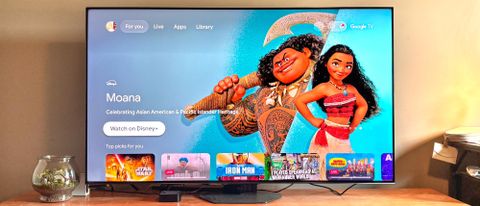Tom's Guide Verdict
The Hisense U8N Mini-LED TV delivers a dream picture at a wildly reasonable price. Yes, you can splurge on an OLED set such as the Samsung S95D, but the Hisense U8N is an amazing value.
Pros
- +
Bonkers brightness
- +
Google TV
- +
ATSC 3.0 tuner
- +
Great value
Cons
- -
Only 2 x HDMI 2.1 ports
- -
Upscaling / color banding
- -
Color accuracy needs tweaking
Why you can trust Tom's Guide
For the last 12 months, the Hisense U8K Mini-LED has held the top spot on our list of the Best TVs — which might sound strange given the fact that it’s neither an OLED or a QD-OLED TV.
However, what the Hisense U8K offered — and what the newer Hisense U8N brings to the table — is an unbelievable price-to-performance ratio. At $1,499 for a 65-inch model ($1,099 when it’s on sale), the U8N is a TV that looks far better than what its sticker price would suggest, and it’s the TV that I would buy for myself, friends and family if I didn’t want to overstretch my budget.
Boasting around 3,400 nits in HDR and SDR, the U8N offers next-level brightness combined with near record-breaking color gamut coverage. There are some soft spots when it comes to upscaling and motion processing (similar to last year’s U8K) but, by and large, the movies, shows and games I played on this TV blew me away.
Minor qualms aside, this is one of the best TVs we’re going to get in 2024.
Hisense U8N review: Price and release date
The Hisense U8N became available around March/April of 2024 as the successor to the Hisense U8K. It sits beneath the two top 2024 Hisense TVs — the Hisense U9N and Hisense UX (2024) — and above the lower-cost Hisense U7N and Hisense U6N.
The Hisense U8N review unit we tested is the 65-inch configuration, but there’s also a smaller 55-inch version and two larger sizes, a 75-inch and 85-inch version, as well. Not sure which size to buy? Check out our guide on ‘What size TV should you buy?’
Here’s the prices and screen sizes for the Hisense U8N:
- 55-inch Hisense U8N Mini-LED TV (55U8N): $1,099
- 65-inch Hisense U8N Mini-LED TV (65U8N): $1,499
- 75-inch Hisense U8N Mini-LED TV (75U8N): $1,999
- 85-inch Hisense U8N Mini-LED TV (85U8N): $2,799
At these prices, should you upgrade from the U8K? There’s probably not enough innovation here to warrant the upgrade, but it’s definitely worth considering if you’re still using the U8H from 2022. Also, if you’re looking to go bigger than the 65-inch option, the 75-inch Hisense U8K can be found for $1,199 while stock lasts — that’s absolutely worth its discounted price.
Hisense U8N review: Design
The Hisense U8N goes very traditional here with a minimal bezel and pedestal stand. The IR blaster that sits on the bottom of the screen pairs with a wonderfully re-designed remote that’s coated in a textured plastic. The back of the TV is a bit thick — so don’t expect a perfectly flush mounting job — but the added depth makes it easy to access the HDMI ports along the left side.
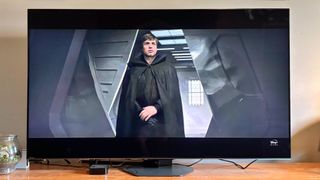
Speaking of ports, let’s get this right out of the way at the top: There’s only two full-spec HDMI 2.1 ports that can transmit a 4K/144Hz signal. The other two ports (HDMI 1 and HDMI 2) are limited to 4K/60 with the former also acting as the eARC port for soundbars and AVRs. This will become more problematic as more next-gen consoles come to the market, but for now you’ll find space on the back for both a PS5 and Xbox Series X or a 144Hz gaming PC.
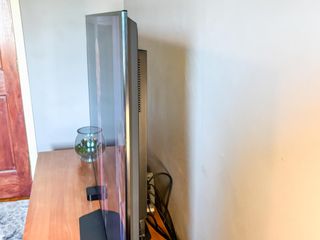
Should you decide you want to use one of the best wall-mounts, the Hisense U8N uses a standard 600 x 400, M6 VESA mount. The 65-inch TV weighs in at 56.2 lbs without the stand so, although you won’t need a body builder to lift it, you’ll probably need someone to help you get it up on the wall.
Hisense U8N review: Performance
By and large, the performance of the Hisense U8N is on par with some of the best QLED TVs we’ve seen from the likes of Samsung and TCL. To wit, everything I watched looked bright, bold and beautiful thanks to the U8N’s Mini-LED panel and thousands of contrast control zones.

Now, usually, OLED TVs get all the praise for having the best black levels, but the U8N offers surprisingly good contrast for an LED-LCD TV. The black bars along the bottom of the screen offer near-OLED black levels while the center-screen action appears bright and colorful.
As long as I stayed away from the overly saturated and eye-searingly bright Vivid picture mode and instead stuck with Cinema Day or Cinema Night modes, 4K movies like Avengers: Endgame and Dune looked incredible with controlled peak brightness of over 2,000 nits and good, accurate colors that contend with the best TVs on the market.
Here’s the only downside: I’ve seen the bleeding-edge of what AI upscaling can do, and with HD content the Hisense U8N doesn’t even come close to that. That’s not to say that upscaling is bad — it’s just middling. You’ll notice some fuzziness in places where there ought to be none. Compared to TVs like the LG C4 OLED or Samsung S95D, faces on the Hisense U8N might look a bit softer with hidden pores and clouds have soft edges rather than any real definition.
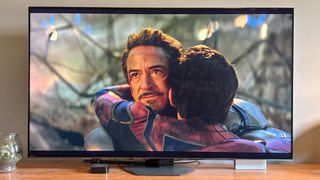
Motion processing, similarly, can hit some hiccups as well when you have elements on the screen moving at different speeds. Watching a car chase in Archer streaming in HD on Netflix, the motion blur around the moving objects was extremely noticeable — but it went away as soon as I switched back to action sequences in Avengers: Endgame where all the elements on the screen were moving at once.
Are these aspects annoying? Yes. Do they also prevent it from being the perfect TV? Also yes — but they’re minor issues and should be treated as such in the grand scheme of things.
Hisense U8N review: Test results
Hisense’s focus with the U8N is brightness and contrast, both of which the TV has in spades thanks to its Mini-LED Pro+ screen. Not only does that make the U8N one of the brightest TVs we’ve ever tested, but it’s also one of the most colorful as well, as denoted by its Rec2020 test.
| Hisense U8N | LG OLED Evo C4 | Samsung QN90C | Samsung QN90D | Sony X90L | |
| SDR Brightness (10%, in nits) | 1258 | 296 | 249 | 248 | 537 |
| Delta-E (lower is better) | 3.2403 | 1.8201 | 1.4542 | 4.2619 | 2.3955 |
| Rec. 709 Gamut Coverage | 98.3141 | 98.9136 | 98.7273 | 99.7672 | 99.8652 |
| HDR Brightness (10%, in nits) | 3296 | 1049 | 1369 | 2091 | 1446 |
| UHDA-P3 Gamut Coverage | 96.77 | 98.15 | 99.09 | 94.43 | 96.56 |
| Rec. 2020 Gamut Coverage | 82.07 | 72.27 | 74.47 | 77.16 | 72.82 |
| Input Lag (ms) | 13.1 | 12.9/9.2 (Boost) | 9.2 | 9.6 | 18.1 |
Let’s start first with the brightness metrics. In HDR, we measured a peak brightness of 3,296 nits, while in SDR, the U8N put out 1,258 nits.
On the color vibrancy side of things, the U8N covered 82.07% of the Rec2020 color gamut — only beaten by the Sony Bravia A95L — and 96.77% of the UHDA-P3 color gamut. The downside here is that the U8N’s out-of-the-box color accuracy leaves something to be desired, having only scored a 3.2403 on its Delta E test where lower numbers are better.
So how does this stack up against the competition? As you can see from the chart, the U8N does a great job. It’s unbeatable in brightness and Rec2020 color saturation, which are two of the most important metrics when it comes to buying a new TV. The small issues with color accuracy and input latency (covered down below) are disappointing, but not deal-breakers.
Hisense U8N review: Gaming
To see how well the Hisense U8N fared with video games, I connected my Xbox Series X to the display and booted up both Fallout 4 with the new performance mode and Tekken 8.
Both games played great, full stop. Fallout 4’s bleak wasteland looked jaw-dropping thanks to the extended color gamut while Tekken 8 ran at full speed without any tearing. My suspicion here is that lesser TVs without VRR support might not be able to keep up with the action, nor would they look as good without Dolby Vision Gaming support.
Admittedly, the 13.1ms input latency does leave a little to be desired considering that many Samsung and LG TVs come in under 10ms, but the 3ms difference is nearly imperceptible.
Hisense U8N review: Sound
A TV’s built-in speakers are never a real replacement for one of the best soundbars, but the Hisense U8N takes its best shot with mild success: Not only can it get supremely loud, but it doesn’t distort as you push it past the lower volume levels. Dialogue was always easy to hear and music, despite lacking a large soundstage, was engaging to listen to for long periods.
The Hisense U8N uses a 2.1.2 surround sound speaker system rated at 60W. As I noted in last year’s Hisense U8K review, I don’t think those extra height channels are really doing much justice to Dolby Atmos audio tracks, but thankfully the TV can pass that signal to an external speaker system with its eARC HDMI port.
Overall, sound quality is good enough right out of the box. For better Dolby Atmos playback, I’d still recommend buying a separate 5.1.4-channel system, but the U8N’s built-in speakers can pump out the jams for a house party and envelop you in a wall of sound in a pinch.
Hisense U8N review: Smart TV
Because it uses the Google TV smart platform, the Hisense U8N definitely earns a spot on our list of the best smart TVs. Navigating Google’s interface is quick and simple, and the constantly refreshed roster of recommendations always has something good to watch.
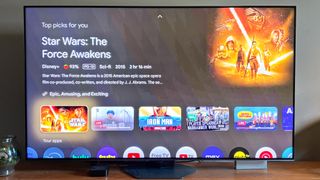
In terms of app coverage, all the major players are here including Netflix, Prime Video, Disney Plus and YouTube, all of which have a shortcut button on the remote. Jumping from one app to the next usually just takes a second or two, but you might experience a slower start time if you haven’t used the app before or are opening it for the first time in a long while.
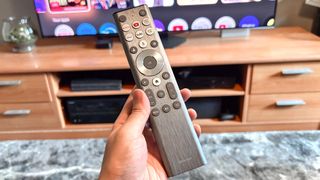
Finally, with Chromecast Built-in, casting your favorite shows and movies from your phone or tablet can be done with just a few taps.
Hisense U8N review: Verdict
The Hisense U8N comes heart-breakingly close to a perfect five-star score and truly deserves its Editor’s Choice award. At this price, it’s a phenomenal option and it’s only going to become cheaper as the months move on. Come Black Friday, I’d be shocked if we don’t see the 65-inch version of this TV on sale for $999.
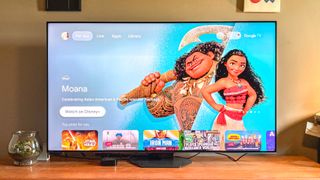
So what are the five-star options at this price point? Right now, there’s nothing. This is the best option. But soon, some big TVs are going to drop down in price — the Samsung S95C OLED is currently sitting at $1,997 on Amazon while the LG C3 OLED can be found for $1,496. If you don’t mind trading away some of that peak brightness for better out-of-the-box color accuracy and superior upscaling, they’re going to provide that to you for a few hundred dollars more.
That being said, at this exact price bracket, I don’t think there’s a better option than the Hisense U8N. It delivers an idyllic picture at a wildly reasonable price.

Nick Pino heads up the TV and AV verticals at Tom's Guide and covers everything from OLED TVs to the latest wireless headphones. He was formerly the Senior Editor, TV and AV at TechRadar (Tom's Guide's sister site) and has previously written for GamesRadar, Official Xbox Magazine, PC Gamer and other outlets over the last decade. Not sure which TV you should buy? Drop him an email or tweet him on Twitter and he can help you out.
